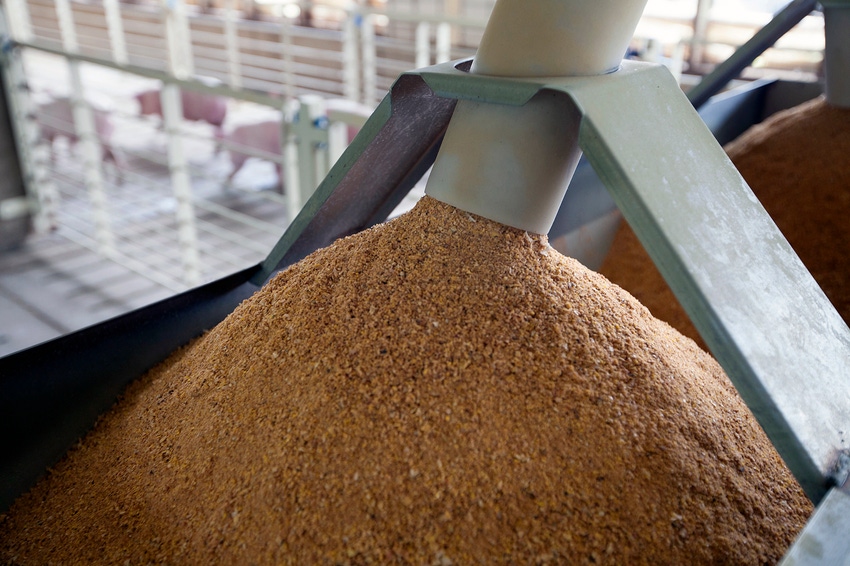A study was designed to evaluate different sampling procedures and number of samples to collect from feeders within a swine facility to achieve an accurate assessment of nutrient fortification in swine diets.
December 21, 2017

By Aaron Jones, Jason Woodworth, Chris Vahl, Steve Dritz, Mike Tokach, Robert Goodband and Joel DeRouchey, Kansas State University
The sampling of finished feed and its subsequent analysis is a common standard operating procedure not only for research trials, but also for quality control programs on farms as a way to assess if feed is being delivered to pigs that matches the formulated targets.
While research articles and bulletins have been published on how to collect a representative sample, as well as others describing analytical or laboratory-to-laboratory variation, we are unaware of any studies to examine exactly how many samples to collect from the feeders, or if samples should be pooled or not to minimize analytical variation. Therefore, a study was designed to evaluate different sampling procedures and number of samples to collect from feeders within a swine facility to achieve an accurate assessment of nutrient fortification in swine diets.
For this study, three-ton batches of feed were manufactured at a commercial feed mill in southwestern Minnesota and delivered to a commercial grow-finish swine barn. The barn contained 42 pens that were each equipped with a four-hole stainless-steel, dry self-feeder (36 inches tall × 60 inches long) with approximately 300 pounds of feed capacity. This sampling study was conducted at the same time a copper titration study was conducted and, as a result, dietary copper ranged from 27 to 147 parts per million in the experimental treatments.
Two sampling techniques (hand versus probe) were tested on a total of six feeders per dietary treatment. For probe sampling, a 63-inch brass open handle probe (Seedburo Equipment Co., Des Plaines, Ill.), which contained 10 openings spaced approximately 2 inches apart, was used. The probe was inserted at a 45-degree angle in relation to the bottom of the feeder to collect approximately half-pound sample. Hand samples were collected by inserting one’s arm into the feeder at a depth of approximately 12 inches and then extracting the cupped hand to collect a sample of approximately quarter-pound. Each sampling technique was repeated within a feeder until approximately 2 pounds of total sample was collected.
Samples were split and ground prior to compositing and analysis. A 200-gram (half-pound) subsample from each individual feeder and sampling technique was collected for analysis. In addition, a subsample (about 33 grams) from each individual feeder and sampling technique was collected and pooled within dietary treatment and sampling technique to form a 200-gram composite sample. This process was repeated until four individual composite samples were created for each diet and sampling technique. Samples were then sent to a commercial analytical lab for copper analysis.

Table 1: Samples size calculations for a given margin of error and a 95% confidence interval
Results indicated that using a probe reduced variability (P = 0.013) for copper in individual samples when compared with hand-sampling. There was no evidence for differences detected among sampling techniques for copper when samples were pooled from six feeders to form a single composite sample. While not statistically significant, the overall variability was numerically reduced when samples were pooled from six feeders to form a single composite sample.
From these results, sampling frequency calculations were determined to assess sampling accuracy within a 95% confidence interval. Results indicated that the number of feeders or composite samples required to analyze was less when using a probe compared to a hand, regardless of nutrient analyzed. For example, six composite samples collected by probe would need to be analyzed to measure copper in feed within 10 ppm of the actual concentration. When collected by hand, nine composite samples would be needed to be within 10 ppm of actual concentration.
In summary, these results suggest that, in general, sampling with a probe is associated with less variability on an individual sample basis. Creating a composite, pooled sample decreases the number of samples that need to be analyzed and decreases the importance of using a probe. Our results suggest that samples should be collected with a probe from six feeders and then composited and subsampled for multiple analysis as the best option to minimize variation and analytical costs.
You May Also Like



